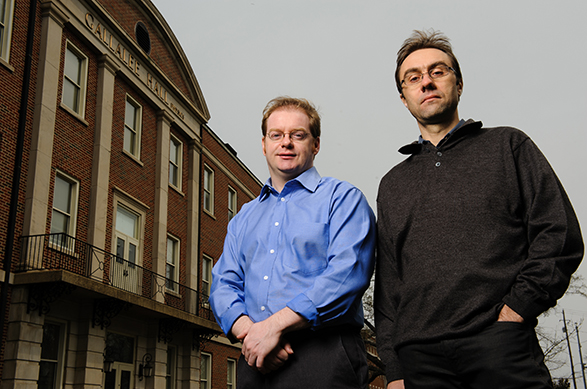
From the June 2015 Desktop News | A team of international scientists, including a pair of physicists from The University of Alabama, resumed efforts this week near Geneva, Switzerland, to use tiny particles to answer big questions – really big – like how the universe works.
Drs. Conor Henderson and Paolo Rumerio, assistant professors in the Department of Physics and Astronomy, are working much of the summer at the Large Hadron Collider, the world’s largest particle accelerator. Located at the European Organization for Nuclear Research, or CERN, the LHC resumed operation this week following a nearly two-year shutdown for upgrades, testing and maintenance.
For the next three years, the accelerator, buried 300 feet underground and boasting a 17-mile circumference, is expected to run 24 hours a day, seven days a week, smashing smaller-than-atom-sized particles together at a new record energy rate. The successful resumption of activities June 3 was greeted with much fanfare, including international media coverage.
“I was fortunate enough to be in the control room of our experiment as part of the monitoring crew when this happened, and it was pretty exciting,” Henderson said. “Now all of us in the CERN experiments will be preparing to operate our detector at peak efficiency and to analyze these new record-high energy collisions for signs of perhaps some new breakthrough in particle physics.”
The LHC was the site of the summer 2012 announcement that the Higgs boson had been identified. The Higgs particle, for which scientists had searched for decades, gives other particles their mass and confirms what’s known as the standard model, a theory of physics that describes how the universe works.
The researchers played roles in that discovery, but they say more discoveries are ahead.
The Department of Energy’s Office of High Energy Physics awarded Henderson and Rumerio a $630,000 grant to support their work for three years. That funding began in May 2014 and also supports the work of two UA post-doctoral researchers, Drs. Otman Charaf and Seth Cooper, and one UA graduate student, Andrew Buccilli.
The research team, according to information provided by CERN, plans to use the LHC to further explore the standard model and look for evidence of physics phenomena that lie outside it.
This could, for example, help explain mysteries such as dark matter, believed to make up about a quarter of the universe, or nature’s apparent preference for matter over antimatter, without which we would not exist, scientists say.
During the summer of 2013, Rumerio spent four months at CERN replacing and testing part of the system’s electronics for the upgrade that improved the experiment’s performance. He’s particularly interested in searching for a different particle called a leptoquark, while Henderson’s interest is piqued by something called a graviton, an exotic particle of gravity that might exist in an alternative theory of gravity involving warped extra dimensions of space.
Both Henderson and Rumerio collaborate on the Compact Muon Solenoid experiment, or CMS, at the LHC. Rumerio first joined the research project in 2005, aiding with the construction of the experiment and the calibrations of two of the experiment’s detector components. He develops software used in analyzing data from the experiment and is one of those analyzing the data.
CERN’s accelerator, like others, produces proton particle beams, which are made to circulate within the experiment’s massive ring. At different stages around the ring, the proton beams collide, and the energy released in these collisions produces new particles. Detectors are built at the collision locations to analyze these produced particles.
The number of particle collisions inside the ring is mind-boggling. The rate of collisions will be progressively increased, allowing the LHC to produce up to 1 billion collisions every second. As the experiment’s electronics can permanently record between 200 and 300 collisions, the scientists developed a method to prioritize which fragments merit further analysis.
Using measurements of energy signal strength, about 100,000 collisions per second are sent to a higher level for a detailed reconstruction of the collisions, or events, as the researchers refer to them. Of those, approximately 200 are typically permanently stored for a full analysis. This level of prioritization is called the trigger system and is the part of the experiment on which Henderson primarily focuses.